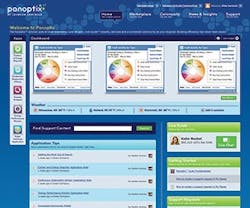Could your management strategies benefit from an extra layer of security and portability?
If you’re hoping to expand the functionality of your existing building automation or management system, you may benefit from linking it to cloud-based monitoring or fault detection. Need to take your management system in the field? Specify a mobile-friendly system for added portability.
Understand the Cloud Concept
The popular buzzword seems vague, but refers to a specific simple concept. “Cloud computing” and its variations refer to applications, files, and other data available in real-time over the Internet. You can then access whatever you store in the cloud from virtually anywhere. If you’ve ever uploaded photos to Flickr or opened a Gmail account, you’ve used cloud computing – specifically, a type called Software as a Service (SaaS).
Can I Benefit from the Cloud?
If your company has the expertise and manpower for extra responsibilities and the infrastructure to store all that extra data, you might choose to manage the system in-house. However, cloud-based management offers extra safety because the vendor (who likely utilizes a sizable, secure data center) hosts your software and data for you. This decision ultimately comes down to user preference.
“There’s nothing preventing you from operating the system in the cloud,” notes Jim Fletcher, distinguished engineer and chief architect of smarter infrastructure at IBM, whose Intelligent Buildings Management software stores data in the cloud. “The end user wouldn’t know the difference, so it’s based on the comfort of the customer.”
In the event that something wipes your hard drive, anything you stored in the cloud will still be hosted safely by the provider. This also cuts down on future data storage needs.
“There are numerous benefits to cloud computing,” says Gary Kummer, director of global sales for Panoptix, a cloud-based efficiency management system by Johnson Controls. “You can access applications anytime – all you need is an internet connection and a browser.”
PageBreak
Tailor Solutions to Your Facility
To find the best fit for you, review the unique needs of your building and department. Consider these factors:
- Which systems do you want to monitor? Some products tie into multiple information sources for a robust picture of how your building is operating. You can also choose a system centered around one goal, such as power consumption. Ask vendors about support for special applications if necessary, such as emergency power supplies, advises Ram Kaushik, offer manager for power management at Schneider Electric, which developed the mobile-friendly energy management system StruxureWare.
- How much support do you want? Assistance varies from a hotline to call for help or a building performance coach who advises you on strategy. Some offerings link to a command center where engineers evaluate alerts and either fix the issue remotely or generate a work order. “Increasingly, facilities find that they lack the time, expertise, and personnel to effectively manage their energy and power systems,” Kaushik notes.
- What technology is already installed? Many products work with existing automation, fire/life safety, or security systems. At minimum, your legacy system has to provide a digital signal, so the old pneumatic automation is out, says Chris Browne, international director for integrated facilities management at Jones Lang LaSalle, which developed the portfolio manager IntelliCommand.
- Do you need to access your management system in the field? If so, consider specifying mobile capability provided by a smartphone app that draws information from the same cloud source your computer does. To display charts and graphs, choose a mobile-optimized version of a dashboard. Text message alerts offer an easy solution for urgent warnings.
Go Beyond the BAS
By itself, a BAS responds to changes in temperature, humidity, or other setpoints to create the environment you specify. Optimize it with cloud-based fault detection to find hidden waste, which the system can bring to your attention with a call, email, or text.
For example, in an auditorium with four air handlers where one uses mechanical cooling and the others are in economizer mode, the BAS will register the situation as normal if the temperature is within the right range, Kummer explains.
Meanwhile, the cloud-based fault detection component examines operating sequences and may correspond with engineers to determine why the fourth air handler is behaving differently. When it finds the source of the inefficiency, it notifies you (and in some cases, generates a work order) so you can take action before too much energy is wasted.
“Think of it as continuously optimizing the performance of the building systems,” Browne adds. “If something is running wrong or out of sequence, it’s corrected.”
Janelle Penny ([email protected]) is associate editor of BUILDINGS.
About the Author
Janelle Penny
Editor-in-Chief at BUILDINGS
Janelle Penny has been with BUILDINGS since 2010. She is a two-time FOLIO: Eddie award winner who aims to deliver practical, actionable content for building owners and facilities professionals.

